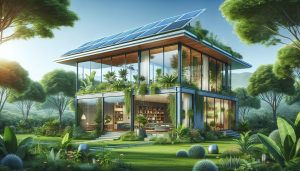In our ever-evolving quest for a greener future, sustainable architecture emerges as a pivotal player within the circular economy. By seamlessly integrating eco-friendly designs with resource-efficient practices, it can help minimize waste and promote the reuse of materials. This harmonious interplay not only reduces our environmental footprint but also fosters resilient communities. Together, let’s delve into how sustainable architecture is reshaping the way we construct, inhabit, and think about our built environment. Have you ever wondered how sustainable architecture fits into the circular economy? It’s a fascinating topic, and today we’re going to delve into it together. Sustainable architecture is more than just a buzzword; it’s an approach to design and construction that minimizes environmental impact while maximizing efficiency and productivity. In the circular economy, where the goal is to create a system that reduces waste and promotes the continual use of resources, sustainable architecture plays a vital role.
Understanding Sustainable Architecture
Sustainable architecture focuses on minimizing the environmental footprint of buildings throughout their lifecycle. This includes the design, construction, operation, maintenance, and eventual demolition.
Key Principles of Sustainable Architecture
There are several foundational principles in sustainable architecture which aim to contribute positively to the circular economy:
- Resource Efficiency: Using materials and resources in the most efficient way to reduce waste and environmental impact.
- Energy Efficiency: Designing buildings that require less energy for heating, cooling, and lighting.
- Water Efficiency: Implementing systems and technologies that reduce water consumption.
- Environmental Quality: Ensuring healthy indoor air quality and utilizing materials that have a minimal environmental impact.
- Lifecycle Design: Considering the entire lifecycle of the building, from construction to demolition and beyond.
Benefits of Sustainable Architecture
The benefits of sustainable architecture span across environmental, economic, and social aspects.
- Environmental: Reduced carbon footprint, less waste generation, and better use of natural resources.
- Economic: Lower operational costs through energy and water efficiencies, and potentially higher property values.
- Social: Improved health and well-being of occupants due to better air quality and natural lighting.
The Circular Economy Explained
Before we dive deeper, let’s clarify what the circular economy entails. Unlike the traditional linear economy (take, make, dispose), the circular economy is designed to be restorative and regenerative by intention and design.
Principles of the Circular Economy
The circular economy operates on a few key principles:
- Design Out Waste and Pollution: Products are designed to not produce waste.
- Keep Products and Materials in Use: Maximize the lifecycle of materials and products.
- Regenerate Natural Systems: Sustainable practices that enhance and support natural systems.
Circular Economy Strategies
A few common strategies in the circular economy include:
- Recycling and Upcycling: Converting waste materials into new products of equal or better quality.
- Maintenance and Repair: Extending the life of products through regular maintenance and repair.
- Product-as-a-Service Models: Shifting from selling products to offering services.
The Intersection of Sustainable Architecture and the Circular Economy
Now let’s explore how these two concepts intersect and complement each other.
Design and Construction
In the circular economy, buildings are designed for disassembly and material recovery. This is where sustainable architecture shines with its focus on lifecycle design.
Material Selection and Waste Reduction
Sustainable architecture emphasizes the use of recycled, renewable, and bio-based materials. In a circular economy, these materials are preferred as they can be easily repurposed or recycled at the end of their life.
| Material Type | Sustainable Architecture Consideration | Circular Economy Benefit |
|---|---|---|
| Recycled Materials | Use in construction and finishes | Reduces need for new raw materials |
| Renewable Materials | Wood, bamboo, other rapidly renewable options | Can be replenished and absorbed CO2 |
| Bio-Based Materials | Natural insulations, bioplastics | Reduce petrochemical use and promote biodegradability |
Energy Systems
Integrating renewable energy sources, such as solar and wind, into building designs aligns perfectly with circular economy goals. Both seek to reduce dependency on finite resources and cut down on greenhouse gas emissions.
Water Management
Sustainable buildings often include systems for greywater recycling and rainwater harvesting. These practices reduce the strain on municipal water supplies and align with the circular economy principle of maintaining and regenerating natural systems.
Building Lifecycle and Disassembly
Designing buildings for easy disassembly means that at the end of their useful life, components can be easily removed, repurposed, or recycled. This is a huge step away from the traditional approach where buildings are demolished and the materials often sent to landfills.
Case Studies
Let’s look at a couple of real-world examples that highlight the role of sustainable architecture in the circular economy.
The Edge, Amsterdam
The Edge is often regarded as one of the greenest and most intelligent buildings in the world. Key sustainable and circular features of The Edge include:
- Energy Efficiency: The building achieves energy neutrality through efficient design and renewable energy sources.
- Smart Technology: Intelligent systems optimize energy use, enhancing both sustainability and occupant comfort.
- Flexible Spaces: The interior can be easily reconfigured, extending the building’s lifecycle and adaptability.
Bullitt Center, Seattle
The Bullitt Center is designed to be a “living building” with a focus on sustainability throughout its lifecycle.
- Net-Positive Energy: The building generates more energy than it uses through solar panels.
- Water Management: Rainwater is collected, treated, and used throughout the building, and greywater is reused for landscaping.
- Material Transparency: All materials were selected based on their environmental impact and ability to be recycled or composted.
Challenges and Solutions
While the integration of sustainable architecture within the circular economy presents vast opportunities, there are also challenges to address.
High Initial Costs
One of the primary barriers is the higher initial investment costs. However, this can be offset by lower operational costs and potential incentives or tax breaks for green buildings.
Resistance to Change
Adopting a new approach to building can be met with resistance from stakeholders accustomed to traditional methods. Education, demonstration projects, and policy support can help in overcoming this barrier.
Limited Availability of Sustainable Materials
While the demand for sustainable materials is growing, they are not always readily available or affordable. Supporting the development and market entry of new sustainable materials can help bridge this gap.
Future Trends
Urban Mining
Urban mining refers to the process of reclaiming raw materials from buildings, products, and infrastructure in urban environments. It’s a promising trend for both sustainable architecture and the circular economy.
Modular Construction
Modular construction involves creating building components off-site in a controlled factory setting and then assembling them on-site. This method reduces waste, accelerates the construction process, and makes it easier to disassemble or reconfigure buildings in the future.
Digital Twins
Digital twins are virtual replicas of physical spaces. They allow buildings to be monitored and optimized through their lifecycle. This technology can help in predictive maintenance and efficient resource management, contributing to both sustainability and circular economy goals.
Policy and Regulation
Government policies and regulations play a crucial role in driving both sustainable architecture and the circular economy.
Green Building Standards
Adopting and enforcing green building standards, such as LEED (Leadership in Energy and Environmental Design) or BREEAM (Building Research Establishment Environmental Assessment Method), can incentivize sustainable architectural practices.
Waste Management Policies
Policies that encourage or mandate recycling, reclamation, and reuse of building materials can help in aligning construction practices with circular economy principles.
Financial Incentives
Providing tax breaks, grants, or other financial incentives for sustainable building projects can help overcome the barrier of initial high costs.
Conclusion
So, what is the role of sustainable architecture in the circular economy? It’s about more than just creating eco-friendly buildings. It’s about integrating resource efficiency, renewable energy, and lifecycle thinking into the very fabric of our built environment. This synergy not only helps us create a more sustainable future but also stimulates innovation and economic growth. By embracing both sustainable architecture and the principles of the circular economy, we can build a world that is not only resilient and regenerative but also a more pleasant and efficient place to live.
Next time you step into a thoughtfully designed, eco-friendly building, remember: it’s not just good design—it’s a crucial piece of a much larger puzzle aimed at creating a sustainable and circular world.



